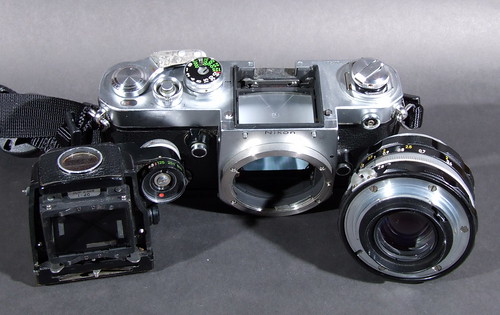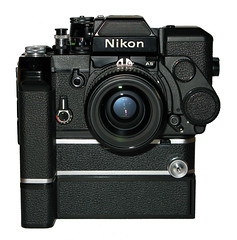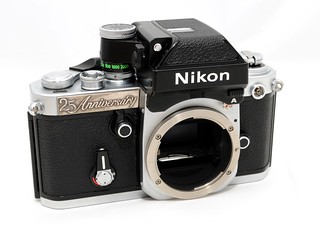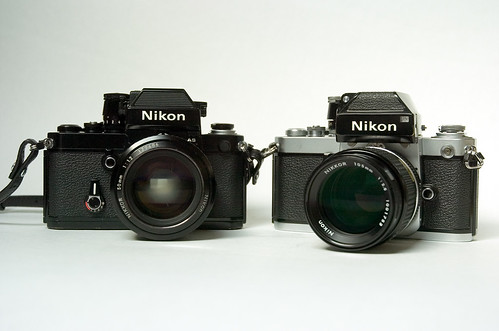Nikon F2

|
| Nikon F2 image by Süleyman Demir (Image rights) |
| Nikon F2 |
|---|
|
Manufacturer: Nikon
Film type: 135 (35mm film)
|
The Nikon F2 is a professional, mechanical system SLR introduced in 1971 by Nikon using F mount. It is the direct successor of successful Nikon F. Instead of an upgrade of Nikon F it is a completely new body only sharing with its predecessor the lenses, some accessories and the overall design philosophy. It was produced concurrently with the (then 12-year old) Nikon F for two years, then became the only Nikon pro-grade system camera until it was replaced by the F3 in 1980. In most ways, the first three mainline models of the Nikon F series each represent the best of a decade in camera design, though they have very individual follies as well. Like most 70's SLR's from major manufacturers, the F2 is metal-bodied, mechanical, and built around a metered-manual paradigm rather than an autoexposure one. It does, however, have some peculiarities, some of them held over from the much older Nikon F.
Overall, the Nikon F2 is a much-lauded camera, used by a generation of professional photographers working in a wide variety of applications. The body is noted as rugged, the shutter as reliable--those who use the Nikon F2 today often note that some examples have worked perfectly since they were made without maintenance, when many pro-grade cameras such as Leicas would need cleaning, lubrication and adjustment every few decades. While this is by no means guaranteed, many, many Nikon F2's are in service today, sometimes with their first owners. They have every possible accessory, from a shutter-speed auto-exposure unit to motor drives to macro focusing bellows, making for a camera that can be quickly adapted to perform to professional standards in a staggering variety of niche applications. For general photography, the body alone can suffice or it can be used with a metered finder head such as the DP-1.
In these regards, the Nikon F2 is not a departure from the F, which was itself versatile and well-built, but rather a refinement. Though very different internally, the F2 was made as ergonomically identical to the original F as possible. Even the weight of the body with the initial DP-1 finder was kept within an ounce of the weight of the departing F with an FTN finder. But the improvements were extensive:
- Extended shutter speed range of 10s to 1/2000 and 1/80 flash sync
- ASA 6 to 6400 with initial DP-1 finder
- Larger reflex mirror to minimize viewfinder vignetting
- Shorter wind lever stroke (120 degrees in a single-stroke--multiple stroke winding is permitted), and integrated on/off switch in film advance lever
- Coupling for motor drive
- Rounded contour body for better ergonomics
- Rewind crank with a 6mm raised position for easier manual film rewinding
- Removable hinged back
- Automatic mode-changing flash sync, X and FP.
Contents
Description
The F2 is an all-mechanical camera body, though it has a body compartment for either 2 lr44-equivalent 1.5v cells, or a double cell of equivalent dimensions and output. These batteries are not used by the body--two contacts on either side of the finder mount conduct power up into any metered finder that is attached. When there is no finder or an unmetered finder, the batteries are not drained, and no power flows when the film advanced lever is in its fully home position.
In most ways the design is that of a normal professional SLR: most of the controls are in their most conventional places, and its ergonomics are common-sense--the shutter release and speed dial are positioned for the right index finger, the stop-down control for the middle finger, the advance lever for the thumb. The mirror lockup is accessed by pressing the stop-down button and rotating the small lever around it towards the lens. Rewind is by a crank, as on most SLR's, and the rewind release is the modern type, a small button on the bottom of the camera.
The camera has a number of fairly unique controls, however: the back release is on the bottom--it is a folding key like the bottom release on a Leica, which is turned to open the back. The hinged back stands in contrast to the Contax-style removable back of the Nikon F. The shutter release does not have a socket for a standard cable release, having instead a "Leica-type" male thread around the button, like many Leicas, several period Nikons and some TLR's; finally, the ring around the shutter release has two settings whose meanings are not immediately apparent to a new user. These are a locking position, as on many professional cameras, which blocks the shutter release to prevent accidental exposure, and a "T" setting which, when used in conjunction with the "B" setting, locks the shutter open and does not allow it to close until the ring is returned to the normal position. the "T" position also allows (for a mechanical camera) extremely long mechanically-timed shutter-speeds. More on this below.
Shutter
The shutter is a fairly advanced mechanical focal-plane design, with curtains that run at a higher speed than many focal plane shutters. This makes it easier to have a top speed of 1/2000th, as the slit can be larger and less susceptible to varying in size as it moves. It also increases the X speed (the highest speed at which the film gate is fully uncovered) from a more typical 1/60th by slightly more than a third of a stop to 1/80th, allowing flash sync at that higher speed.
Conceptually, the shutter resembles a much more advanced, 1970's version of a Leica III-style shutter--this is to say, it has two speed selectors for two different speed ranges. On the Leica III, speeds below 1/50th were selected on a second dial, which introduced a second, slower timer into the mechanism. On the Leica, this merely introduced the slow speeds we now take for granted on later cameras: 1/30th down to one second.
On the Nikon, the main dial goes all the way down to 1 second, plus B (bulb exposure.) For even longer exposures, the self timer doubles as the second, slower shutter timer. This is accomplished by setting the main shutter dial to B, setting the ring around the shutter release to "T" and selecting a speed by swinging the self-timer lever until the indicator lines up with the desired number of seconds. When the shutter is released (via the shutter release button, not the self-timer button, in this instance), the self timer will become connected to the shutter release mechanism and hold the shutter open while it runs down. This gives speeds from 2 seconds to 10 seconds, though over time, without service, the timer will naturally slow down and these speeds will become inaccurate, much as the slowest speeds on the normal dial will.
There is a small window in the center of the shutter speed dial, in which a rotating indicator shows whether the shutter is cocked. It turns a full circle for every cycle of the shutter. It is, of course, completely obscured when any metered finder is mounted.
The shutter curtains are rubberized foil with a honey-comb pattern of oblong shapes embossed on it, not the rubberized cloth more common in focal plane shutters of this era. This makes it more resistant to burning if the mirror is locked up and the lens is left focused on the sun--it will still be damaged eventually, however.
The film advance lever includes a power switch that turns on and off the power supply to any metered finder that is mounted. When it is pulled out slightly past a light catch, a red dot on top of the camera is exposed and the meter receives power through the contacts.
Viewfinder
As a true system camera, both the viewfinder and the focusing screen are separately interchangeable, and the camera can be used in waist-level mode without a viewfinder. The viewfinder is released by a recessed button on the top left rear of the camera, which is best pressed by a penny or a dime. Most finders for this camera have their own latching mechanism, which must also be released to remove them. To remove the focusing screen, the same button is held down and the camera is turned upside down, allowing it to fall freely out of its holder. Standard with the camera was a basic focusing screen, the Type A, with a split-image focusing device and a 12mm ring to indicate the area weighted by the meter. Others include several matte focusing screens, a number with microprisms only, as well as the Type K, which has both split-image device and microprisms like most upscale SLR's[2], and the Type L, which is identical in all regards with the Type A, except that, like some of the very first split-image devices (see Rectaflex), its split is aligned at a 45 degree angle, such that both vertical and horizontal lines in the subject can be used for focusing.
The finders fall into two varieties: metered and un-metered. Most unmetered viewfinders were non-pentaprism units for specialty applications--there was a waist-level viewing hood, an eye-level vertical "chimney" finder with high magnification for critical focusing, as well as a similar one with a 90 degree prism and a large pentaprism "action finder" with a large window and high eye-relief, for applications like sports photography (and in practice, for people who wish to look through the viewfinder without removing their glasses).
There is also the unmetered DE-1 prism, which is ostensibly the standard finder for the F2, but which is somewhat uncommon to find with the camera, as the various versions packaged with metered prisms well outsold the Standard F2. The DE-1 and most other prism finders have a contact which connects to various Nikon shoe-mount flashes, in order to light a small light in the eyepiece when the flash is charged to fire.
The five different metered finders have large pentaprisms for a bright image with high magnification. None of these finders offer autoexposure on their own, only metered-manual ("exposure confirmation"). They all have shutter-speed dials that fit over and turn the camera's shutter-speed dial, sensing its position for the meter, as well as for a rotary indicator in the viewfinder.
All metered prisms also have a mechanism that senses the position of the aperture ring. The mechanism differs between those finders built primarily for pre-AI lenses and those built for AI lenses.
The three pre-AI meters require lenses with the special "rabbit ears" coupling flange, which was standard on most pre-AI lenses, optional on most AI lenses and continued to be offered on new Nikon lenses up until very recently. To mount a lens requires manually turning the aperture ring to both ends of its range[3] in order to apprise the meter of the maximum aperture. On these three F2 finders the aperture lever automatically snaps into this flange as the lens is mounted.
On the other hand, the two AI meters sense the special flange on AI lenses to determine this information automatically. While the convenience of the latter "autoindexing" system is lauded, and it was a vital transitional step towards the modern Nikon lens system, the mechanisms involved cannot read pre-AI lens aperture rings, and these lenses can only be metered stopped-down when used with these finders--and the coupling tab must be moved out of the way before mounting the lenses. Many photographers who use older lenses thus prefer the DP-3 as the most advanced pre-AI finder--especially as it can use AI lenses with the "ears."
All of these finders show full exposure information via indicators at the bottom of the frame--shutter speed, aperture and correct exposure indicator. In the DP-1 and DP-11 the exposure indicator is a needle moving across an oval window; in all others, it is either two or three LED's, which indicate over, under and correct exposure. In the DP-11 and DP-12 (both for AI lenses), the aperture indicator is a periscope that views the second set of aperture markings on the lens adjacent to the camera body; in the three earlier finders, which are primarily for pre-AI lenses that lacked this second aperture scale, the aperture indicator works much like the shutter-speed indicator--transparent numbers on a black disk, lit by translucent windows on the exterior of the finder.
There are different versions of the F2 depending on the finder attached to the body. The body comes in chrome or in black. The plain prism finder DE-1 also comes in chrome, black and special titanium finish. All other finders are in black only.
- Standard F2 (1971-'76) has the plain prism finder DE-1. Mounts and uses any Nikon SLR lens with an aperture ring (and fixed-aperture lenses). Manual exposure only.
- F2 Photomic (1971-'76) has the metered finder DP-1. It works with both Pre-AI and AI lenses, and indicates exposure with a needle. After the introduction of the F2S, it remained in production as a cheaper model.
- F2S (1973-'76) has the finder DP-2; DP-2 is similar to DP-1 except it uses two red LED's instead of a needle, and meters below one second. Pre-AI and AI.
- F2SB (1976-'77) has the finder DP-3; DP-3 is an improvement of DP-2 using rapid-sensing silicon-blue cells and a three-LED exposure indicator. It meters as low as ten seconds wide open at ASA 100. Pre-AI and AI.[4]
- F2A (1977-'80) has the finder DP-11, which is the auto-indexing version of DP-1. This is a cheaper version than the F2AS. Only AI lenses fully supported.
- F2AS (1977-'80) has the finder DP-12, which is the auto-indexing version of DP-3. AI.
- F2T or F2 Titan (1976-'80) is a light, rugged titanium version of the F2, with a unique finish. In all other ways beside the material of the housing and the coating of that material, it is identical to the Standard F2, having its own matching titanium-clad DE-1 plain prism finder included with it. There is no official designation for this finder besides DE-1, but to collectors they are different finders and while the plain DE-1 commands extreme prices, sometimes more than an entire F2 Photomic, the Titan DE-1 is an extremely sought after and scarce item in a league of its own for price.
(Note well that, despite models being named by the finder mounted on them, any of these finders will mount on any body--there is some additional value to collectors if the finder and the camera have compatible serial numbers, which indicates a possibility that they were sold together. For instance, DP-3 and a body with a serial number in the 77xxxxx range (production year beginning 1977) are considered a "date compatible" F2SB, and it will likely be assumed that they shipped as a unit.)
Flash
The Nikon F series is notorious for having special proprietary hot shoes, at least until much later (after the Nikon F3). The shoe is large and the rewind crank sits squarely in the middle of the shoe, such that the flash must straddle it. Special Nikon flashes have a shoe mount that looks more like an upside-down ISO hot shoe itself, to slide over the rewind crank and the contacts which sit on either side. Adapters exist, and for non-shoe-mount flashes, there is a PC socket immediately in front of the flash shoe.
Just as unusual, though perhaps more convenient for the photographer of the time (and thoroughly useless to modern photographers) is the automatic mode-switching in the flash sync mechanism. The camera is synchronized for X sync (electronic flashes) and FP sync (flat peak flashbulbs, which stay lit for much longer than M-sync bulbs, so that they can be used with focal plane shutters at high speeds). As these are different timings to be used with different shutter speeds, the camera must switch between two sets of contacts to be synchronized for both types of flash. Nowhere on the camera is any control or marking related to the sync--rather, when the camera is at or below "X" speed (1/80th, given as a numberless mark between 1/60th and 1/125th), the camera is set to X-sync. When it is set from 1/125th up, it is set to FP-sync. This is scarcely even mentioned in the manual for the camera.
The strange side-mounted flash shoe did have one advantage--it allowed the flash ready light to be conveniently connected to the flash unit via the side-mounted contact on most F2 pentaprism heads. This allows the photographer to see that the flash is ready without lowering the camera.mo
Shutter-speed priority
On its own, the camera has no autoexposure. However, there are cumbersome motorized units (the DS-1, sold for DP-2, DS-2, sold for DP-3 and DS-12, sold for DP-12) that can be mounted around the lens mount. These drive the aperture ring and communicate with the finder for exposure information, allowing shutter-speed priority automation. This is the reason for the small tab with contacts that protrudes from these finders on the photographer's left. These devices also supplant the camera body batteries as the power source for the finder, and can turn the finder on even when the on-off lever is in its "off" position.
Unlike, say, the auto-exposure modules for Canon New F-1, the DS units do not require a motor drive to operate. In fact, combining motor drive, battery and DS unit on an F2 will result in one of the largest and heaviest 35mm still cameras ever. The DS units do require compatible metered finders.

|
| Nikon F2 Titan with AS-Finder, Motor Drive MD-2, Battery-pack MB-1 and DS-12 EE Aperture Control Unit image by wolf4max (Image rights) |

|
| Nikon F2A, 25th Anniversary image by KEH Camera (Image rights) |
Notes
- ↑ or 1.55v in the case of the silver oxide SR44
- ↑ the type K is believed to have become standard with all F2's manufactured after about 1976
- ↑ the so-called "Nikon shuffle"
- ↑ This is the most advanced camera that has full native support for pre-AI lenses, and because of its short production and popularity, is usually the most expensive finder.
General links

|
| Nikon F2AS versus F2 Photomic image by Paul Moore (Image rights) |
In English:
- Legendary Nikons: Nikon F2, at Nikon's History & Technology site
- Debut of Nikon F2, at Nikon's Camera Chronicle
- Nikon F Collection & Typology (includes F2 bodies and accessories), by Richard de Stoutz
- Listing of Nikon product numbers during the F2 era, from a 1973 ad in Camera 35 (Vol. 17, No. 3; pages 16-17).
- Specialist Nikon F2 Repair & Restore Services by Sover Wong
- Nikon F2 Photomic (1971) with MD-2 motor drive by luis triguez
In Spanish:
- Nikon F2, by Daniel Jiménez, at Del infinito al plano focal
- Nikon F2 Photomic AS in the website of Hugo Rodriguez
In French:
- Nikon F2 on www.collection-appareils.fr by Sylvain Halgand
Literature and manuals
- Nikon F2 instruction manual - English at at M.Butkus' www.orphancameras.com
| Nikon 35mm SLR Cameras | |
|---|---|
| Nikkorex F | Nikon EL2 | Nikon EM | Nikon F | Nikon F2 | Nikon F3 | Nikon F4 | Nikon F5 | Nikon F6 | Nikon F50 | Nikon F55 | Nikon F60 | Nikon F65 | Nikon F70 | Nikon F75 | Nikon F80 | Nikon F90 | Nikon F90X | Nikon F100 | Nikon F-301 | Nikon F-401 | Nikon F-401S | Nikon F-401X | Nikon F-501 | Nikon F-601 | Nikon F-601M | Nikon F-801 | Nikon F-801s | Nikon FA | Nikon FE | Nikon FE2 | Nikon FE10 | Nikon FG | Nikon FG-20 | Nikon FM | Nikon FM2 | Nikon FM2n | Nikon FM3A | Nikon FM10 | |
| Nikomat / Nikkormat | |
| EL | EL2 | ELW | FS | FT | FT2 | FT3 | FTN | |